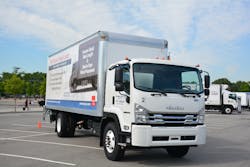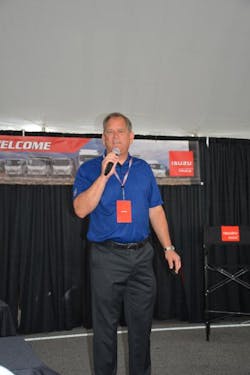QUEENS, NY. The rapid shift from traditional retail store shopping to the purchase of products over the internet is driving major changes to delivery networks as well – including changes to the capabilities of the trucks tasked with making those deliveries.
During a ride and drive event held in the shadow of New York City’s Citi Field, Isuzu Commercial Truck of America and Canada showed off its brand-new Class 6 FTR medium-duty cabover truck model, which the company believes is positioned perfectly to benefit from e-commerce driven growth in the delivery of goods to residential areas.
“When you look at where a lot of packaged goods are now being delivered, places of business or home, versus going to retail outlets, this is an outstanding vehicle,” Shaun Skinner, Isuzu’s president, told Fleet Owner.
“There’s a couple of things advantageous that it [the FTR] brings to the marketplace,” he stressed. “The first is its cab-forward [cabover] design and really from the outset is for urban delivery. A cab-forward product allows not only for a crowded environment, it allows for great visibility and better maneuverability.”
Skinner noted that the FTR’s four-cylinder diesel engine gives it a unique advantage as well, as Freightliner is the only other truck maker in the market offering a four-cylinder diesel engine in a Class 6 product.
“We believe that brings with it a number of advantages, number one being fuel economy,” he pointed out. “Our vehicle has outstanding fuel economy … and that drives down the cost of ownership.”
The FTR is powered by a turbocharged 4HK1-TC engine four-cylinder diesel engine that offers “B10 life” of 375,000 miles, meaning that 90% of those engines should reach that mileage before requiring an overhaul.
“Some people could look at that [a four-cylinder engine] as a perceived weakness,” added Skinner. “We look at it as a strength [because] we’re not looking to put it into highly vocationalized areas where you have this robust use of the vehicle from a standpoint of horsepower and torque requirements. This is going to be more of a delivery and pick-up vehicle. From an ownership standpoint, the four-cylinder engine will really be an advantage.”
The New York event at Citi Filed is one of several Isuzu held in recent weeks across the country to help familiarize its fleet customers and dealers with its new Class 6 FTR cabover.
“A lot of the design work [for the FTR] was done in the U.S. at the Isuzu Technical Center of America in Plymouth, MI,” Skinner said. “Usually for trucks in this market a great deal of the design [by Isuzu] is done in Japan. It’s assembled at the same campus as our gas truck is, with our partner Spartan Motors in Charlotte, MI.”
Isuzu expects to begin shipping the FTR by early July. “There’s still a few things we have to make sure of, but so far zero defects have been found,” Skinner noted.
“We’ve been out of the Class 6 product since 2009, so this is the first chance we’ve had to reintroduce it in the U.S. and Canada markets,” he added.
“That’s because our original strategy was attached to our alliance with General Motors,” Skinner explained. “When they declared bankruptcy, one of the things that went away was the medium duty, their commercial truck part of the medium duty. So when we lost that alliance we had to reformulate how to get back to the U.S. and Canada markets with a Class 6 product.”
But once Isuzu found itself able to re-enter the Class 6 market on its own, “we got very excited, because there are about 40,000 Class 6 cab-forward customers out there with not a lot of options,” Skinner emphasized. “We have a high level of U.I.O’s, units in operation, that haven’t had anything since 2009. It’s exciting for us that we now have a product we can bring to market for these people.”
About the Author
Michael Catarevas
Michael Catarevas is a former managing editor at FleetOwner. He wrote for the publication from 2017 to 2020.

